A broken foot could be the result of a sudden injury or due to long-term stress on the foot. The time required for the injury to heal completely depends on factors like its severity, the affected bone, and age of the injured person. Read this article to find out about healing time for a broken foot.
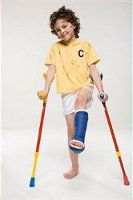
"When our feet hurt, we hurt all over." -
SocratesThe human foot has a total of 26 bones. A broken foot implies that any of these 26 bones can be broken or fractured. The bones of a foot might break or get injured due to a number of reasons. Some of them are recurring mechanical stress, an accident, a fall, or a severe sprain. The amount of time required for a foot injury to heal completely, will depend on the bone which is fractured, severity of the injury, and the type of fracture.
The healing process is completed in three stages: inflammatory/injury, consolidatory/bone production, and maturation/bone remodeling. The entire broken foot healing process spans an average of 12-15 weeks. This duration does not include physical therapy sessions. Physiotherapists strongly recommend patients to follow specific exercise regimens that enable faster and stronger healing of the bone.
Know Your Foot
The human foot comprises 19 muscles, 26 bones, 33 joints, and 107 ligaments. That is 38 muscles, 52 bones, 66 joints, and 214 ligaments in both the feet! 25% of the bones of your body are present in the feet. This makes the bones in the foot more susceptible to injury than any other part of the body.
The human foot is divided into three parts - the hindfoot, the midfoot, and the forefoot. It has 7 tarsal bones, 5 metatarsal bones, and 14 phalanges. Two of the tarsal bones, the talus, and the calcaneus, form the hindfoot, and the remaining tarsal bones form the midfoot. The forefoot is made up of the metatarsals and the phalanges. A broken foot could mean a crack or deformation in any of these bones.
The Healing Process: Stages and Duration
The probability of bones being broken is more in an adult or a grown up than in children. Ironically, fractures heal a lot faster in children than they do in grown ups. This is because the osteoblasts (cells that are involved in bone formation) are more active in children than in adults. The osteoclasts (cells that are responsible for bone resorption) work faster than osteoblasts in older adults.
Every bruise, wound, injury or fracture follows a set pattern while healing. It is necessary to understand this pattern in order to be familiar with the various stages that your injury or fracture will go through. Each stage is characterized by a specific activity that aids in recuperation. The time for completion of each stage differs with the severity of the injury and the age of the patient; the sequence, however, remains the same.
The broken foot is healed completely in three stages; namely, injury or inflammation, stabilization or bone production, and maturation or bone remodeling.
The Healing Process of a Fractured Bone
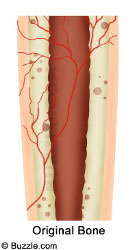
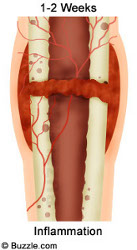
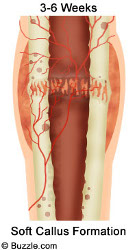
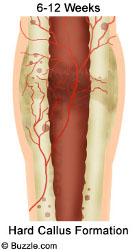
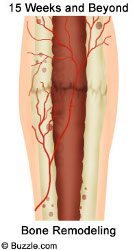 I. Injury or Inflammation
I. Injury or Inflammation
This stage is primarily characterized by mechanical damage of the tissue, be it bones, muscles or ligaments. The patient experiences acute pain at this level. The injury may or may not cause bleeding, but clotting of blood cells (called hematoma) around the fracture is inevitable. Blood clots lay down a framework or foundation for the bone healing. Inflammation of the wound, which is nothing but response of the body tissues to injury, starts as soon as the bone is fractured. The wound may remain in the inflammatory stage for
a week or two at least, depending on the type and severity of the injury.
As mentioned earlier, the healing process begins as soon as the person gets hurt; inflammation around the injury causes white blood cells to rupture the damaged tissue, and initiate the growth of new tissue in its place. The body is designed to function in a way that, if it registers the occurrence of a wound, the supply of blood, oxygen, and other nutrients to that area automatically increases to make up for lost levels of blood, minerals, calcium, and other essentials.
The patient needs to take lots of care at this stage, as any activity or mobilization might deter the healing process and deteriorate the condition of the fracture.
II. Consolidation or Stabilization or Bone Production
As the name suggests, the body tries to stabilize the wound in this stage. Consolidation is the integration of two parts into one. In a fracture, the clotted blood around the broken bone is gradually replaced by fibrous tissue and cartilage. The broken bone repairs itself in two stages. First is the formation of the soft callus or cartilage, which is completed in a time frame of
three to six weeks. This tissue is extremely thin, weak, susceptible to breakage, and cannot be visible on X-ray scans.
The next stage is the formation of hard callus or hard bone, which is a stronger tissue than the soft callus. The formation of this layer can be observed and monitored on X-ray films. The duration of this stage ranges from
six to twelve weeks from the day the bone was fractured.
III. Maturation or Remodeling or Bone Remodeling
The cartilage formed in the previous stage slowly starts transforming into hard callus. In its final stage of healing, the fractured bone unifies. Bone remodeling is initiated as soon as the broken bone has unified. Ideally, the bone keeps remodeling itself for years, to come back to its original form. But an average of
twelve to fifteen weeks is enough for the bone to heal, before the patient can get back to basic activities like walking and running. With time, the bone morphs back to its original shape and regains its original strength.
The R.I.C.E Method
The time period for a broken foot to heal depends largely on the type of fracture or the cause of the injury. The major categories are displaced fracture, non-displaced fracture, open (compound) fracture, and closed (simple) fracture. Other types are greenstick fracture, spiral fracture, compression fracture, oblique fracture, transverse fracture, and comminuted fracture.
The minimum time required for these fractures to heal completely is around 10 to 12 weeks. In any case, until you get to the doctor and confirm the status of the injury, the R.I.C.E. method should be followed.
R -
Rest. The wound should be as immobilized as possible.
I -
Ice. Applying ice over the wound helps in minimizing the discomfort due to injury and pain.
C -
Compression. Securing the wound tightly with a bandage reduces swelling.
E -
Elevation. The foot should ALWAYS be elevated, ideally, above hip level. This reduces discomfort and swelling.
Causes and Risk Factors
The leading cause of a fracture or broken foot is subjecting the bone to an intense force which exceeds the bone's endurance capability. The force could be the result of a direct, high intensity blow, or chronic stress, or a pathological disease, or old age.
An accident, a fall from a height, a high impact sprain, etc. are all examples of direct blows that are capable of breaking bones.
Chronic stress in the bones of the foot is characterized by repetitive shocks directed towards the same area of the bone. This wears out the bone and makes it weaker, thus rendering it incapable to withstand any external force. Stress fractures are common among dancers, runners, and sportspeople.
Pathological causes of fractures include diseases like osteoporosis in which there is abnormal loss of bone tissue. The bones become weak, porous, and susceptible to fractures, breaks, and cracks. Osteoporosis occurs due to lack of calcium and is common among the postmenopausal women.
As a person ages, his body tissue weakens and becomes less resilient to injuries and stress. This increases the chances of bone breakage in the old age. Other risk factors include obesity, history of fractures in the patient, lack of calcium, and demineralization.
Symptoms of a Broken Foot
You will know that you have a broken foot when:
▸ You experience excruciating pain in that bone.
▸ You find that the area around the bone has swollen up.
▸ You cannot move or use that body part in a normal way.
▸ You feel partial or total loss of function in the area.
▸ You observe an irregular deformity in or around that bone.
▸ You can see that the bone protrudes outside the skin.
▸ You experience cramps and spasms in the surrounding body tissue.
What Slows Down the Process of Healing?
Many factors impede the recuperation of a broken foot. Some of them are:
▸ Old age - Fractures in older individuals heal slowly as compared to young adults.
▸ Smoking - This affects the blood circulation adversely, and thus hinders the healing process.
▸ Complex fractures - The greater the damage to a bone, the more is the time required for recuperation.
▸ Hasty mobilization - If the patient tries to use the injured body part too soon, the healing process takes a few steps backwards and it takes all the more time to recover.
▸ Improper medical or post-surgical care.
▸ Anti-inflammatory drugs - Sometimes, medications can slow down the process of healing.
▸ Infection in or around the fracture might slacken the pace at which the wound heals.
How to Speed Up the Process of Healing?
Once the fracture has healed to its optimum point, regular sessions of physiotherapy will help accelerate the strengthening process of the wound. The patient should consult a good physiotherapist who will help in devising the accurate physical therapy program, including the diet that needs to be followed, the medication that needs to be taken and the exercises that need to be done. Proper care and immobilization until the crack has healed will surely ensure recovery and regular functioning in no time.
Injuries cannot be avoided, but with proper care, they can heal faster. It is, therefore, important to follow instructions of your doctor and avoid carelessness in order to recuperate wholly. With the right medical aid, appropriate diet, and disciplined physiotherapy sessions, it is possible to heal a broken foot.
Disclaimer:
This article is for informative purposes only, and should not be treated as a substitute for professional medical advice.


 "When our feet hurt, we hurt all over." - SocratesThe human foot has a total of 26 bones. A broken foot implies that any of these 26 bones can be broken or fractured. The bones of a foot might break or get injured due to a number of reasons. Some of them are recurring mechanical stress, an accident, a fall, or a severe sprain. The amount of time required for a foot injury to heal completely, will depend on the bone which is fractured, severity of the injury, and the type of fracture.
"When our feet hurt, we hurt all over." - SocratesThe human foot has a total of 26 bones. A broken foot implies that any of these 26 bones can be broken or fractured. The bones of a foot might break or get injured due to a number of reasons. Some of them are recurring mechanical stress, an accident, a fall, or a severe sprain. The amount of time required for a foot injury to heal completely, will depend on the bone which is fractured, severity of the injury, and the type of fracture.



